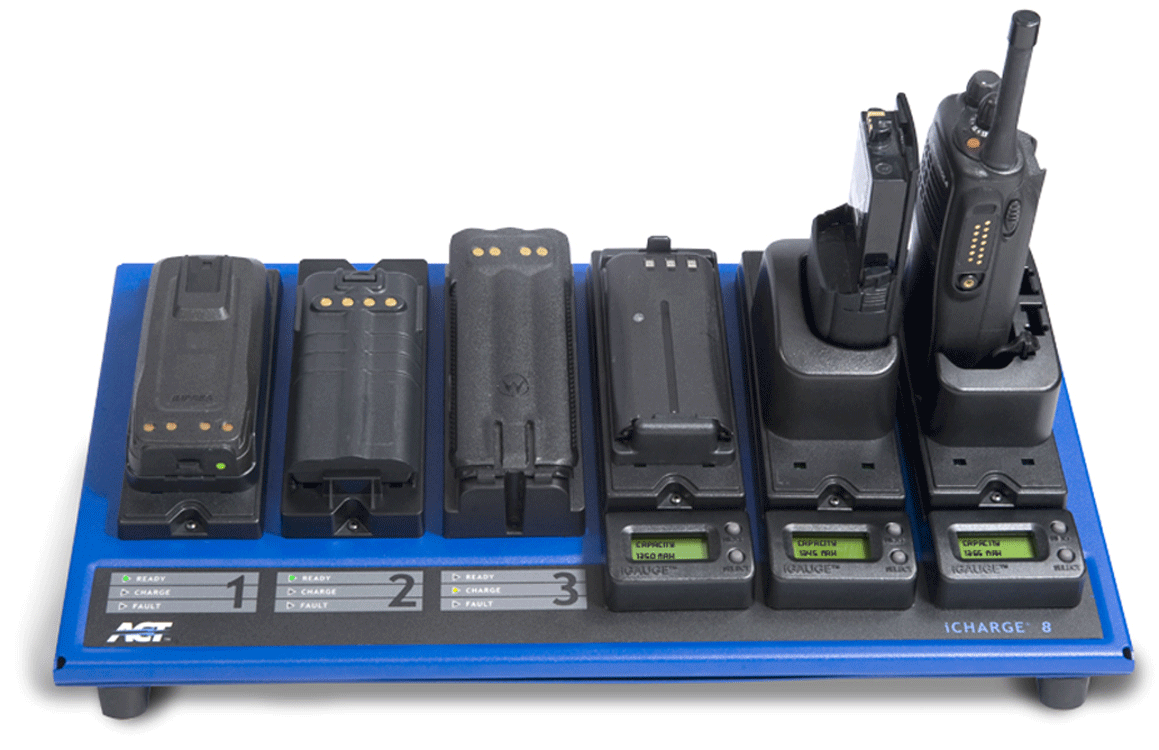Bob Wylie, Director
Advanced Charger Technology
Since its incorporation in the late 1990s, Advanced Charger Technology (ACT) has maintained its focus on the charging and maintenance of rechargeable batteries used on portable two-way radios and thermal imaging devices. Throughout this time there has been a trade-off at the user level in terms of overall weight considerations, battery costs and energy demands of the battery from enhancements in radio features.  The evolution of battery chemistry technology, each with its own unique set of charging requirements, has represented the biggest challenge to our market goals.
The evolution of battery chemistry technology, each with its own unique set of charging requirements, has represented the biggest challenge to our market goals.
In the mid to late 1990s, Nickel Cadmium (NiCD) was the primary battery chemistry used in portable two-way radio devices. The cadmium in the battery was soon widely criticized for its negative impact on the environment, yet NiCD batteries were found to be very robust, had long shelf lives and were quite safe to use. The other major criticism of NiCD batteries was that they were relatively heavy for most portable radio users, which served to limit the overall battery capacity. In addition, NiCD was very susceptible to increased dendrite formation and lost battery capacity resulting from “topping off” of the battery.
In the early 2000s, nickel metal hydride (NiMH) battery chemistries rose in popularity to compliment and in many cases replace the NiCD batteries on two-way radios. NiMH was positioned as not suffering the same environment concerns as NiCD; however, it is generally not considered as robust a chemistry. NiMH does not release current as effectively as NiCD, which is especially noticeable under cold weather conditions, but it does offer the ability for increased battery capacities without adding appreciable weight, relative to NiCD. While NiMH also can suffer from dendrite formation and lost battery capacity it is not as susceptible as NiCD. Although NiM did not replace NiCD completely, it took a large part of the market primarily because it was lighter and therefore was generally of higher capacity. It was more expensive and had a shorter life cycle than NiCD.
While Lithium chemistry batteries have been available for some time, it was not until the mid 2000s when this chemistry gained wide stream acceptance from end users.
Compared to nickel-based batteries, lithium-based batteries have a higher energy density making them more compact and lighter. Lithium also offers a higher cell voltage and lower self-discharge. However, lithium is very volatile and needs to be very carefully charged and maintained. The run-time due to the low weight and therefore high capacity is longer as compared to nickel-based batteries but the overall battery cycle life is not as good. Also, the most common concern with lithium is the ever-present danger of thermal runaway or fire risk as has been publicized on a number of occasions with laptop batteries.
 Over-charging is a very real danger of damaging lithium battery cells. While not the explosive event that has lead to recalls of some laptop and car batteries, this damage results in permanent and irreparable harm to battery cells. This is not recent news, as was published back in 2008, “Permanent capacity loss, as the name implies, refers to permanent loss that is not recoverable by charging. Permanent capacity loss is mainly due to the number of full charge/discharge cycles, battery voltage and temperature. The more time the battery remains at 100 percent charge, the faster the capacity loss occurs.”1 ACT has developed a means to control the termination levels in order to maximize the battery life cycle.
Over-charging is a very real danger of damaging lithium battery cells. While not the explosive event that has lead to recalls of some laptop and car batteries, this damage results in permanent and irreparable harm to battery cells. This is not recent news, as was published back in 2008, “Permanent capacity loss, as the name implies, refers to permanent loss that is not recoverable by charging. Permanent capacity loss is mainly due to the number of full charge/discharge cycles, battery voltage and temperature. The more time the battery remains at 100 percent charge, the faster the capacity loss occurs.”1 ACT has developed a means to control the termination levels in order to maximize the battery life cycle.
In 2011, Advanced Charger Technology, Inc. launched its new generation of charging technology. These new generation chargers focused on charging termination sequences for both nickel-based and lithium-based cell batteries as well as its charging algorithms for the different battery chemistries. This resulted in chargers capable of charging nickel- and lithium-based chemistry batteries to the batteries maximum safe capacity without the danger of thermal runaway and without the generation of heat to compromise the battery.
The revised charging termination sequence will ensure that there is no overcharge and overheating of the battery thereby extending the life cycle of the battery.
As newer battery chemistry technologies gain wider acceptance, such as the growth of lithium polymer, ACT is committed to meeting the unique demands these batteries while still mindful of other battery chemistries still in use.
Reference
1 Power Electronics Technology, April 2008. “Proper Care Extends Li-Ion Battery Life” by Fran Hoffart
For more information please visit www.actcharge.com.







